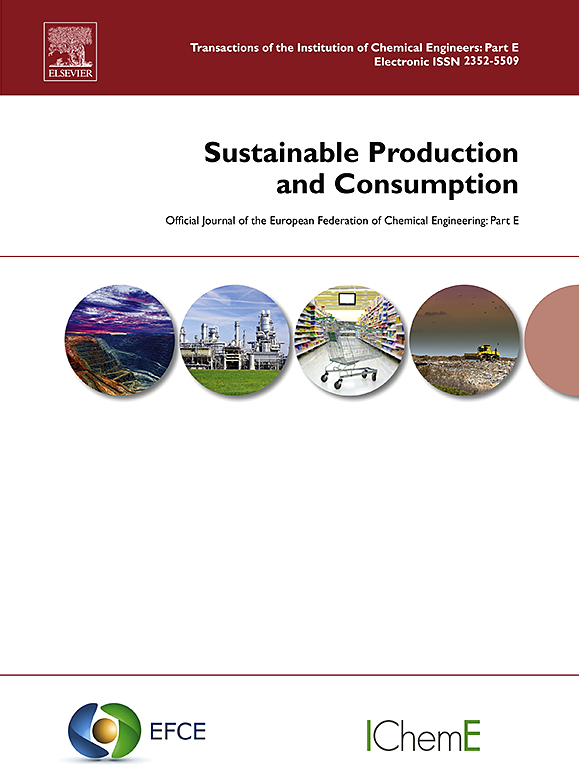IF 10.9
1区 环境科学与生态学
Q1 ENVIRONMENTAL STUDIES
引用次数: 0
摘要
中国是世界上最大的苹果生产国和消费国,在全球水果行业发挥着重要作用。然而,有关中国苹果从生产到消费过程中苹果损失对环境影响的研究很少。从整个生命周期的角度对苹果产业采取合理的举措,可以指导可持续决策,并为制定实现碳中和的政策提供支持。本研究采用了 ReCiPe2016 方法,因为它涵盖了广泛的可能环境影响。本文旨在对中国苹果从生产到消费的环境影响以及供应链上相关的苹果损失进行全面的生命周期评估。结果显示,生产 1 千克苹果产生的全球升温潜能值为 0.842 千克二氧化碳当量。氮肥是苹果生产阶段最关键的环境热点,在 18 个环境影响类别中,氮肥对 11 个类别的影响超过 60%。苹果消费阶段的环境影响一般随运输距离的增加而增加。然而,短途航空运输(国内市场)比长途卡车运输(国际市场)对环境的影响更大。在国内市场的五种消费情景中,包装对环境的影响(1.767-17.926 mPt)高于运输(0.729-14.949 mPt);相反,在国际市场,包装(10.968 mPt)对环境的影响低于运输(12.181 mPt)。此外,研究还发现,更复杂的销售模式导致苹果损耗率更高,需要更充足的苹果生产来满足需求,从而增加了环境污染物排放。中国可以采取减少氮肥用量、设计可持续包装、不鼓励空运、关注苹果损耗等措施来应对这些挑战。这些措施对于改善中国苹果供应链的环境绩效至关重要。因此,迫切需要为从生产到消费的整个生命周期中的不同利益相关者提出一些建议,以实现可持续发展。我们的工作有助于为苹果产业提供一个开启未知知识的蓝图,最终促进苹果系统可持续生产和消费的实现。本文章由计算机程序翻译,如有差异,请以英文原文为准。
Life cycle assessment of apple production and consumption under different sales models in China
China is the largest producer and consumer of apples and plays a vital role in the fruit sector worldwide. However, few studies have examined the environmental impacts of apples from production to consumption in China concerning apple losses. Adopting reasonable initiatives in the apple industry from a whole life-cycle perspective can guide sustainable decision-making and support the formulation of policies for achieving carbon neutrality. This study utilized the ReCiPe2016 methodology because it covers a broad spectrum of possible environmental impacts. The aim of the paper was to conduct a comprehensive life cycle assessment of the environmental impacts of apples from production to consumption in China and the associated apple losses along the supply chain. The results showed that producing 1 kg of apples produced the global warming potential of 0.842 kg CO2-eq. Nitrogen fertilizer was the most critical environmental hotspot in the apple production phase and contributed more than 60 % in 11 of the 18 environmental impact categories. The environmental impacts in the apple consumption phase generally increased with transport distance. However, short-distance air transport (domestic market) had a higher impact than long-distance truck transport (international market). Among the five consumption scenarios in the domestic market, packaging had a higher environmental impact (1.767-17.926 mPt), exceeding transportation (0.729-14.949 mPt); conversely, in the international market, packaging (10.968 mPt) had a lower impact than transportation (12.181 mPt). Additionally, the study found that more complex sales models resulted in higher apple loss rates, requiring more adequate apple production to meet demand and thereby increasing environmental pollutant emissions. China can take measures such as reducing nitrogen fertilizer usage, designing sustainable packaging, discouraging air transportation, and concerning apple losses to address these challenges. These actions are essential for improving the environmental performance of the apple supply chain in China. Therefore, there is an urgent need to make some recommendations for different stakeholders in the whole life cycle, from production to consumption, to achieve sustainable development. Our work can contribute to offering a blueprint for unlocking unknown knowledge for the apple industry, ultimately catalyzing the realization of sustainable production and consumption in apple systems.
求助全文
通过发布文献求助,成功后即可免费获取论文全文。
去求助
来源期刊

Sustainable Production and Consumption
Environmental Science-Environmental Engineering
CiteScore
17.40
自引率
7.40%
发文量
389
审稿时长
13 days
期刊介绍:
Sustainable production and consumption refers to the production and utilization of goods and services in a way that benefits society, is economically viable, and has minimal environmental impact throughout its entire lifespan. Our journal is dedicated to publishing top-notch interdisciplinary research and practical studies in this emerging field. We take a distinctive approach by examining the interplay between technology, consumption patterns, and policy to identify sustainable solutions for both production and consumption systems.
 求助内容:
求助内容: 应助结果提醒方式:
应助结果提醒方式:


